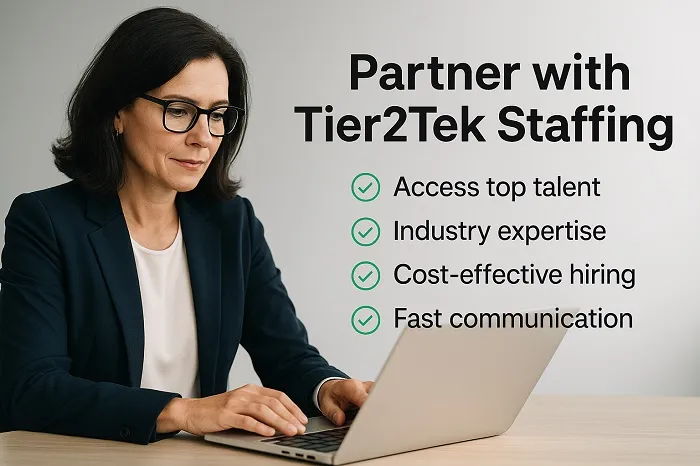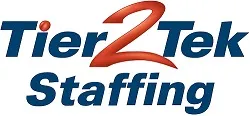IT Hiring & Placement Solutions

IT & Engineering Staffing Solutions That Deliver Results
Looking beyond short-term staffing fixes, Tier2Tek Staffing positions itself as a premier IT & Engineering Staffing Agency specializing in direct hire recruitment. Our focus is on quality and longevity—connecting businesses with candidates who bring not just the right skills, but the right mindset and motivation for lasting success. With over 20 years of experience, we continue to help companies in July find the talent they need to scale and succeed long-term.
We Staff for a Full Range of IT Positions
We help businesses fill critical IT roles across all levels. Whether you’re building a support team or scaling advanced technical departments, Tier2Tek has you covered:
| Category | Positions |
|---|---|
| Support & Infrastructure | Service Desk, Desktop Support, NOC, System Administrator, Network Engineer, Telecom |
| Security & Cloud | Cybersecurity, Cloud, VMWare Administrator |
| Data & Intelligence | Database Administrator, Data Scientist, Business Intelligence |
| Development & Design | Software Developer, UI/UX, SEO Analyst, Copywriter, Technical Writer |
| Leadership & Strategy | IT Architect, Business Analyst, Systems Analyst, Change Management |
| Emerging Technologies | Machine Learning, DevOps |
| Enterprise Platforms | ServiceNow, Workday, SharePoint |
| Specialized Roles | Instructional Designer, IT Auditor, Windows Deployment Technician |
Success Stories from the Field

Healthcare
Challenge: Slow IT support was affecting patient care and operational efficiency.
Solution: Tier2Tek provided help desk technicians with healthcare software and HIPAA expertise.
Result: Response times improved by 50%, enhancing patient service and operations.

Finance
Solution: Tier2Tek delivered a team of system administrators and cybersecurity experts to modernize infrastructure.
Result: Increased system uptime and strengthened compliance with financial regulations.

Manufacturing
Solution: Tier2Tek staffed experienced business intelligence analysts and data scientists.
Result: Improved reporting accuracy and faster decision-making for production planning.
Why Hiring Managers Choose Tier2Tek

Access Top Talent
In-Depth Local Knowledge
Lower Your Hiring Costs
Responsive & Transparent
Flexible Hiring Solutions
Proven Hiring Success
What Tier2Tek Brings to Your Business
Partnering with Tier2Tek means getting more than resumes. We provide strategic hiring support designed to save you time, reduce stress, and ensure your team is filled with the right people for the job. Our industry insight and proactive approach help your business stay competitive with top-tier IT talent at every level.
Comprehensive Recruitment Process
- Identify your hiring needs
- Locate qualified candidates
- Conduct initial vetting
- Deliver top selections

Candidate Screening Approach

- Skill Validation
- Behavioral Interviewing
- Employment Stability Check
- Cultural Fit Review
Our Statistics and Success in IT Support Recruitment
98%
High Placement Success Rate
Over 98% of our placements are rated as ‘excellent’ by our clients.
☝ Week
Rapid Placement Times
The average time from understanding client needs to candidate placement is under one week.
95%
Client Retention
95% of our clients return for their future staffing needs, affirming our capability and service quality.
Placement Guarantee
We fully back our placements with a guarantee. If a candidate doesn’t meet your expectations, Tier2Tek Staffing will quickly find a replacement. Your satisfaction is our top priority and shows our commitment to excellent staffing.

Direct Hire Recruitment — USA & Beyond
Tier2Tek provides top-tier staffing services across the United States and internationally in Europe, UAE, Qatar, and Saudi Arabia. Count on us 24/5 (Monday through Friday) for reliable, high-quality recruitment support.
Ready to Build Your IT Team?
Tier2Tek is your go-to IT recruitment agency for finding the skilled professionals you need to grow. Contact us today and see why we’re one of the best IT staffing companies for businesses nationwide.
Tier2Tek IT Recruitment FAQ’s
We can fill most IT positions in as little as three days, depending on how quickly the hiring manager provides feedback and moves through the interview process.
Our high placement success rate, quick turnaround times, and commitment to quality and client communication make us a preferred choice for IT staffing needs.
We offer competitive pricing with fees that are lower than the industry average.
Yes, we offer a satisfaction guarantee on our placements. If a candidate does not meet your expectations, we will work with you to find a suitable replacement.
Absolutely, we have the resources and expertise to handle high-volume hiring needs, ensuring a smooth and efficient process for large-scale recruitment efforts.
We provide IT staffing services across the United States, catering to clients in various regions and ensuring access to top talent nationwide.
